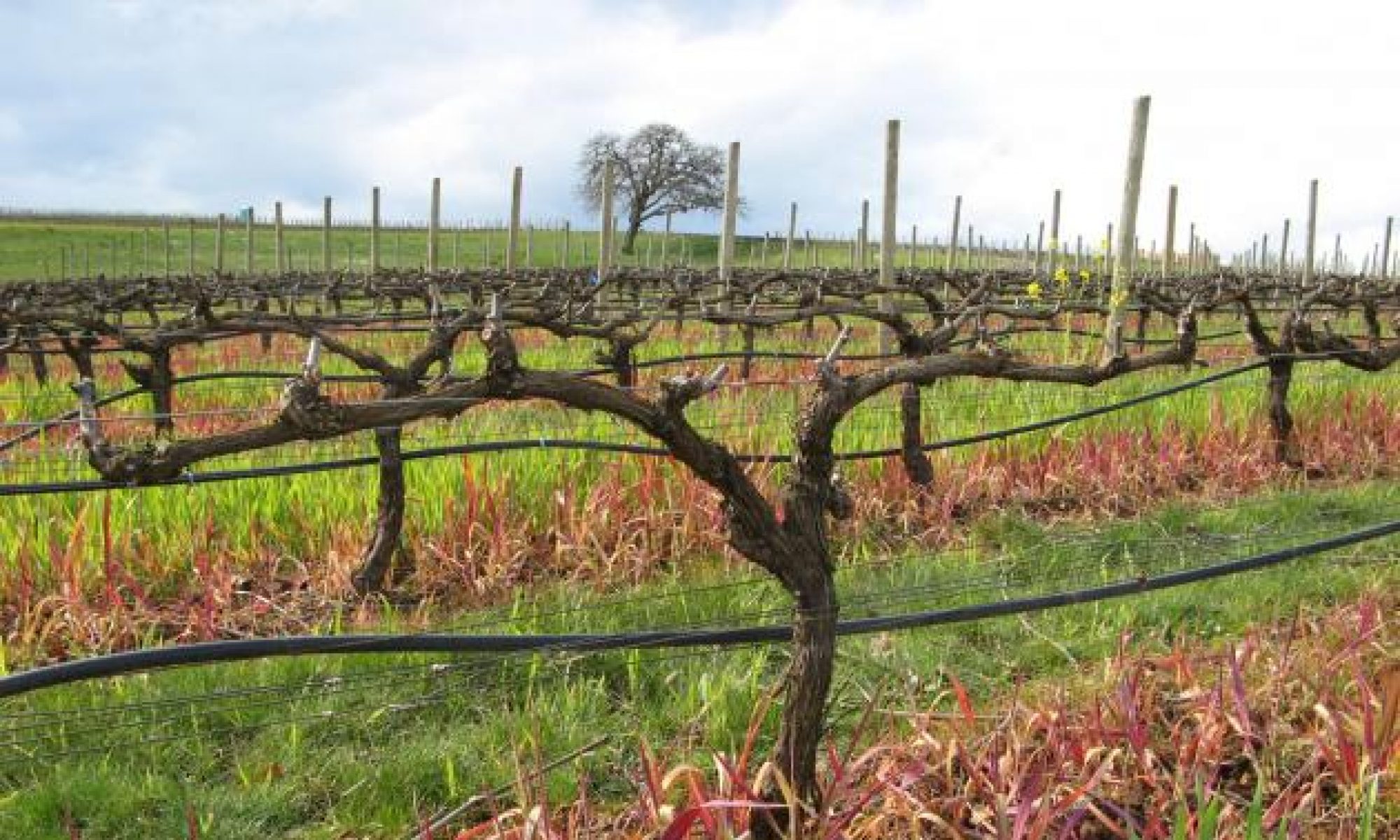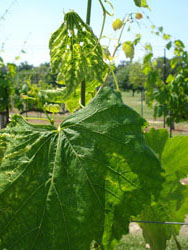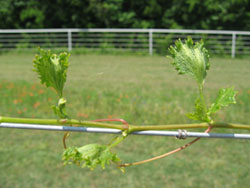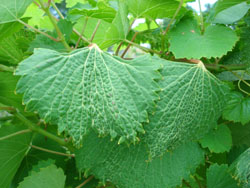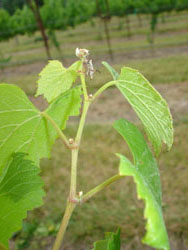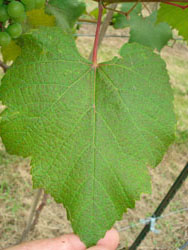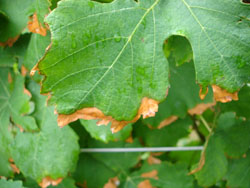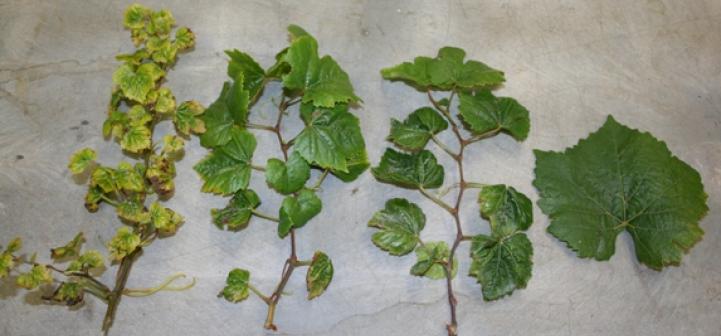
Diagnosis Chemical Disorders Environmental Disorders Nutritional Disorders Discovering Patterns More Info
Fritz Westover, Texas A&M University, and Jim Wolpert, UC Davis
Damage or disorders of grapevines can arise from a wide array of causal factors. Sometimes a spot on a leaf or berry can be caused by an insect or a biological plant pathogen, such as a fungus or bacteria, and other times the spot can be produced by human or environmental factors. A disorder on a grapevine that is not caused by a living pest or pathogen is referred to as an abiotic disorder.
Diagnosing a Disorder
Before diagnosing a grape problem as abiotic in nature, it is important to rule out any potential grape pests or diseases that may have produced the symptom. Several guides, such as the Compendium of Grape Diseases or the Grape Doctor, can be useful tools for diagnosing pest or disease symptoms. Some pests or diseases will produce symptoms on grapes that are commonly confused with abiotic disorders, thus it is important to consult your local agricultural Extension agency to confirm a diagnosis prior to implementing treatment.
Chemical Disorders
Herbicide damage. From top left, going clockwise: Simizine damage, glyphosate damage, phenoxy damage (bottom photos). Photos by Fritz Westover, Texas A&M University.
Leaf spots are one of the most commonly occurring symptoms of abiotic disorders. Leaf spots can be caused by unintentional drift or overspray of herbicides [1], or improper mixing of pesticides or fertilizers sprayed directly onto vines. Even when growers apply a product that was harmless in the past, fluctuations in weather or product rates can lead to unintended damage to vines. For example, many sulfur formulations can cause leaf scorch if applied during hot, humid conditions, whereas copper fungicides can cause similar injury if sprayed during cool, wet conditions. Also, failure to clean the spray tank before applying another product may lead to misapplication and leaf and cluster spotting.

Herbicide drift is likely the most common cause of leaf spots or misshapen leaf growth. Contact herbicides such as glufosinate or paraquat can produce brown necrotic spots on leaves, but generally do not result in vine death if the contact is limited. It is important to note that not all herbicide damage may be the result of grower applications. Drift of systemic herbicides such as glyphosate can cause more severe damage, resulting in leaf distortion and possible vine death. Phenoxy herbicides such as 2,4-D can drift from agronomic crop fields in the vicinity of a vineyard, causing irreversible distortion to leaves, and in some cases, vine death.
If your vineyard is irrigated, test the water quality periodically for impurities. High salt content in irrigation water or salt buildup in soil also can cause leaf scorch or vine death if not detected early.
Environmental Disorders
Environmental factors also may be the cause of spots on leaves. Ozone, for example, may cause oxidant stipple on the upper sides of leaves of susceptible grape varieties if atmospheric levels are elevated in the region surrounding a vineyard. Hydrogen fluoride also has caused leaf burn or necrosis in vineyards adjacent to industrial facilities where such atmospheric pollutants are produced. Drought is another environmental factor that can severely limit vine growth. Drought conditions can reduce nutrient uptake in vines, causing nutrient deficiencies and leaf discoloration. Long periods of drought can lead to death of vine shoot tips, stunted vine growth, and delayed fruit maturation. Other environmental hazards include hail, sunburn, frost, and freeze injury.
Environmental disorders include shoot tip dieback caused by drought (L) and oxidant stipple caused by ozone. Photos by Fritz Westover, Texas A&M University.
Nutritional Imbalances
Nutrient toxicities and deficiencies. From top left, going clockwise: Iron chlorosis on high pH soil in wet conditions, boron spray toxicity, and sulfur burn (bottom photos). Photos by Fritz Westover, Texas A&M University.
Grape leaf discoloration or deformation also can be caused by nutritional deficiencies or toxicities [2]. Nutrient deficiencies can be difficult to diagnose, especially if multiple nutrients are lacking. It is best to submit soil and plant tissue for analysis at a reputable testing lab and discuss the results with an Extension specialist in your area or your crop consultant prior to diagnosing a nutrient related disorder. An over-application of a fertilizer is often easier to diagnose, as the grower can review farm records with a professional to determine if a product was improperly applied. Also, soil tests may indicate other underlying factors that may be predisposing the vineyard to a nutrient imbalance.
Figuring Out Patterns
The pattern of symptom expression is often a key to understanding the nature of the disorder. Growers should try to answer these questions:
- Are leaf symptoms on basal, middle, or apical leaves on a shoot?
- Are symptoms on exterior or interior leaves only?
- Are symptoms on some individual shoots or on all shoots of a vine?
- Are leaf symptoms on leaf margins or some other distinct pattern?
- Are vines with symptoms clustered together or scattered throughout the vineyard, or are they just on the edge rows or vines?
- Are vines associated with any topographic character of the site, such as a swale or hilltop?
- What is the time of year or growth stage when symptoms appear: spring as shoots are beginning to grow, early summer around flowering time, late summer as clusters begin ripening, or in fall at or after harvest?
Growers should document their observations with written notes and photographs, especially close-up photos of symptoms.
Summary
Grapevine disorders can be the result of both biological and abiotic factors. When determining the cause of a disorder symptom in the vineyard, it is important to consider all factors that could contribute to the problem. In some cases, the symptom may be caused by a chemical or fertilizer the grower has applied, or that drifting from a neighboring field. In other cases, the problem may be caused by an environmental pollutant or extreme weather. There are instances where a grapevine disorder can be remedied by grower intervention, but not all disorders will be within the control of the grower. Accurate and rapid diagnosis of a disorder is essential before a plan can be implemented to correct the problem and mitigate future recurrence.
Recommended Resources
Compendium of Grape Diseases. 1988. American Phytopathological Society.
Identifying Pests and Abiotic Disorders, University of California
Scouting Vineyards and Diagnosing Problems, Michigan State University
Grape Disease Management Overview
Herbicide Injury on Grapevines
Frost Injury, Frost Avoidance, and Frost Protection
Monitoring Grapevine Nutrition
Grapevine Nutrition – online learning module and diagnostic tool
Integrated Crop Management of Grapevines PowerPoint, Michigan State University
Reviewed by Patty Skinkis, Oregon State University and Ed Hellman, Texas AgriLife Extension
